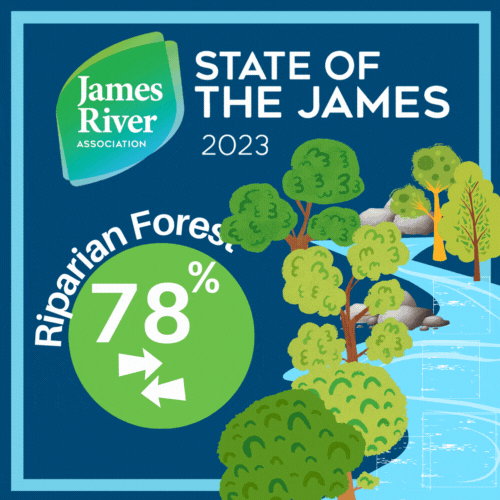Streamside Forests
What are Streamside Forests and why are they important?
Riparian buffers are the trees, shrubs, and other vegetation along our waterways.These streamside forests provide the James River and its tributaries with the protection they need. Riparian buffers slow flood water, improve water quality by filtering runoff from upland land use, provide canopy cover to shade and cool the stream, provide habitat for a variety of birds and small mammals, and are a great place for recreational activities such as fishing, hiking, and bird watching.

The State of the James is a report card summarizing ongoing efforts to bring the James River back to full health. This comprehensive assessment of the health of the river is published every two years. View the report to see how the river’s health has changed.
What are we doing?
- We are committed to restoring streamside forests by partnering with the Department of Forestry and offering the James River Buffer Program. This program assists landowners within eligible areas of the Middle James River watershed with planting riparian buffers on waterways on their land. The program pays for: project design, site preparation, installation and 3 years of establishment maintenance.
- Partnerships are the key in restoring our riparian forests! In 2019, we formed the Upper and Middle James Riparian Consortium. This group of partners share a common vision of “Growing partnerships to create healthy streamside ecosystems for clean water in the James River today and tomorrow.” Check out www.jamesriverconsortium.org to learn more about what we and our partners are up to and how you can be a part of restoring our streamside forests across the James watershed!
- Maintaining healthy riparian forests is also important! We work with volunteers to identify common invasive plant species, teach proper removal techniques, and lead invasive plant species removal days, particularly in riparian areas along the James and its tributaries. We are partners in the James River Park System Invasive Plant Task Force in Richmond.
What can you do?
- Volunteer with the James River Park System Invasive Plant Task Force! Visit the calendar for upcoming dates, invasive plant species removal days, particularly in riparian areas along the James and its tributaries. We are partners in the James River Park System Invasive Plant Task Force in Richmond.
- Wondering what streamside forest programs are out there and who to contact? Visit https://jamesriverconsortium.
org/programs/ to explore the Streamside Program Report tool, created by the Chesapeake Conservancy. You can enter a few basic questions about your land and objectives. The tool will narrow down eligible programs in your area and provide you with a report about your property and program information. - Whether you own land that needs a buffer or want to volunteer to plant trees, you can be part of restoring our riparian forests! Visit www.jamesriverbuffers.org, call (434) 286-7000, or email buffers@thejamesriver.org for more information.

